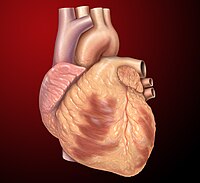
Vascular complications associated with percutaneous left ventricular assist device placement: A 10‐year US perspective
Sign Up to like & getrecommendations! Published in 2019 at "Catheterization and Cardiovascular Interventions"
DOI: 10.1002/ccd.28560
Abstract: Over the last decade, there has been a significant increase in the use of percutaneous left ventricular assist devices(p‐LVADs). p‐LVADs are being increasingly used during complex coronary interventions and for acute cardiogenic shock. These large… read more here.
Keywords: percutaneous left; complications associated; associated percutaneous; vascular complications ... See more keywords

Anticoagulation versus antiplatelet therapy after percutaneous left atrial appendage closure—subanalysis from the multicenter LAARGE registry
Sign Up to like & getrecommendations! Published in 2021 at "Journal of Interventional Cardiac Electrophysiology"
DOI: 10.1007/s10840-021-01080-1
Abstract: Data regarding post-procedural antithrombotic therapy following percutaneous left atrial appendage (LAA) in real-world populations using various occluder systems is limited. In the present analysis, anticoagulation (AC) was compared against antiplatelet therapy (APT) using data from… read more here.
Keywords: percutaneous left; closure; laarge; atrial appendage ... See more keywords

TCT-742 Percutaneous left atrial appendage closure following transcatheter aortic valve replacement: results from the ATTRACTIVE study
Sign Up to like & getrecommendations! Published in 2018 at "Journal of the American College of Cardiology"
DOI: 10.1016/j.jacc.2018.08.1965
Abstract: Atrial fibrillation (AF) is observed in approximately one third of patients undergoing transcatheter aortic valve implantation (TAVI), most often in need for anticoagulation due to their high stroke risk. On the other hand, hemorrhage in… read more here.
Keywords: percutaneous left; 742 percutaneous; aortic valve; tct 742 ... See more keywords

Prevalence and Severity of Aortic Regurgitation Due to a Percutaneous Left Ventricular Assist Device (Impella 5.0): A Retrospective Observational Study.
Sign Up to like & getrecommendations! Published in 2022 at "Journal of cardiothoracic and vascular anesthesia"
DOI: 10.1053/j.jvca.2022.10.010
Abstract: OBJECTIVES Placement of the Impella 5.0 percutaneous left ventricular assist device may cause aortic regurgitation (AR) due to malcoaptation of the aortic leaflets. The authors investigated the prevalence and severity of AR during Impella 5.0… read more here.
Keywords: impella; percutaneous left; prevalence; ventricular assist ... See more keywords

Percutaneous left atrial appendage closure: current state of the art
Sign Up to like & getrecommendations! Published in 2017 at "Current Opinion in Cardiology"
DOI: 10.1097/hco.0000000000000367
Abstract: Purpose of review The authors reviewed the seminal and more recent literature surrounding the major modalities for percutaneous left atrial appendage closure used in contemporary practice, with particular emphasis on safety and efficacy, technical challenges,… read more here.
Keywords: percutaneous left; appendage closure; appendage; atrial appendage ... See more keywords

Comparison of intracardiac and transoesophageal echocardiography for guidance of percutaneous left atrial appendage occlusion: A meta‐analysis
Sign Up to like & getrecommendations! Published in 2019 at "Echocardiography"
DOI: 10.1111/echo.14415
Abstract: We performed a meta‐analysis to compare the safety and efficacy of intracardiac echocardiography (ICE) vs transoesophageal echocardiography (TOE) for the guidance of percutaneous left atrial appendage occlusion (LAAO). read more here.
Keywords: percutaneous left; transoesophageal echocardiography; guidance percutaneous; echocardiography ... See more keywords

Gender‐specific outcomes after percutaneous left atrial appendage closure: A nationwide readmission database analysis
Sign Up to like & getrecommendations! Published in 2022 at "Journal of Cardiovascular Electrophysiology"
DOI: 10.1111/jce.15359
Abstract: Thromboembolism‐associated stroke is the most feared complication of atrial fibrillation (AF). Percutaneous left atrial appendage closure (pLAAC) is indicated for stroke prevention in patients with AF who can not tolerate long‐term anticoagulation. We aim to… read more here.
Keywords: percutaneous left; left atrial; appendage closure; atrial appendage ... See more keywords

Causes and predictors of immediate and short‐term readmissions following percutaneous left atrial appendage closure procedure
Sign Up to like & getrecommendations! Published in 2022 at "Journal of Cardiovascular Electrophysiology"
DOI: 10.1111/jce.15659
Abstract: Percutaneous left atrial appendage device closure has been offered as an alternative to anticoagulation for high‐risk patients with nonvalvular atrial fibrillation. Given the relative novelty of the procedure, we aimed to analyze the rates and… read more here.
Keywords: percutaneous left; closure; atrial appendage; left atrial ... See more keywords

Clinical application of percutaneous left atrial appendage occlusion guided only by transesophageal echocardiography without fluoroscopy and angiography in the patients with nonvalvular atrial fibrillation
Sign Up to like & getrecommendations! Published in 2022 at "Journal of Cardiac Surgery"
DOI: 10.1111/jocs.16463
Abstract: The objective of this study was to understand the clinical efficacy and application of the percutaneous left atrial appendage occlusion (PLAAO) guided only by the transesophageal echocardiography (TEE) in patients with nonvalvular atrial fibrillation (NVAF),… read more here.
Keywords: percutaneous left; guided transesophageal; application percutaneous; appendage occlusion ... See more keywords

Analysis of outcome of 6-month readmissions after percutaneous left atrial appendage occlusion
Sign Up to like & getrecommendations! Published in 2021 at "Heart"
DOI: 10.1136/heartjnl-2021-319345
Abstract: Objective Percutaneous left atrial appendage occlusion (LAAO) is an alternative strategy for prevention of thromboembolic events in patients with atrial fibrillation and unsuitable for long-term oral anticoagulation. The study aimed to evaluate the causes and… read more here.
Keywords: percutaneous left; heart; appendage occlusion; within months ... See more keywords

Percutaneous left atrial appendage occlusion discrepancy between randomised trials and clinical practice
Sign Up to like & getrecommendations! Published in 2022 at "Open Heart"
DOI: 10.1136/openhrt-2022-002079
Abstract: In patients with atrial fibrillation and previous episodes of bleeding on oral anticoagulant treatment, left atrial appendage occlusion (LAAO) has emerged as an alternative way to decrease the risk of stroke. The use of the… read more here.
Keywords: percutaneous left; left atrial; appendage occlusion; atrial appendage ... See more keywords